 We learned a bit about the Gardners , namely Richard, Cape Ann Planters as they soon were to be called, in our previous post but I will now give a bit of our decent from that lineage in this one. The English Gardners came to this country in the days immediately following the landing of the the Pilgrims at Plymouth, as several merchants in South England sent fishing vessels to the shores of New England. The amount of time required by these slow moving vessels to return to the markets of England and Spain made it too late to dispose of their catch . Therefore a number of men in Dorchester, England, put together the Dorchester Company and came up with the idea of establishing a plantation at Cape Ann. Their thinking was that the fishermen might winter there, make their catch early in the spring, and return to England in season to dispose of the fish to advantage.
We learned a bit about the Gardners , namely Richard, Cape Ann Planters as they soon were to be called, in our previous post but I will now give a bit of our decent from that lineage in this one. The English Gardners came to this country in the days immediately following the landing of the the Pilgrims at Plymouth, as several merchants in South England sent fishing vessels to the shores of New England. The amount of time required by these slow moving vessels to return to the markets of England and Spain made it too late to dispose of their catch . Therefore a number of men in Dorchester, England, put together the Dorchester Company and came up with the idea of establishing a plantation at Cape Ann. Their thinking was that the fishermen might winter there, make their catch early in the spring, and return to England in season to dispose of the fish to advantage. 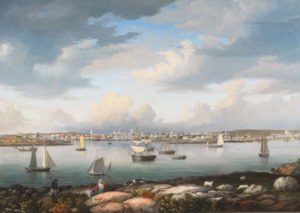
In 1624, The Cape Ann Planters landed at Stage Point on the west side of what is now Gloucester harbor. Col. Charles Edward Banks , “The Planters of the Commonwealth,” records the following in his list of ships arriving in 1624.
“Zouch Phenix. She was consort of the Unity, and arrived with her in the spring of this year. It is believed she sailed from Weymouth and brought the following passengers:
Thomas and Mrs. Gardner, George, Richard, Joseph Gardner.
John Balch, Mrs. Agnes Balch, Benjamin, and John Balch,
Thomas Gray
Walter Knight
William Trask
John Tilley
Peter Palfrey
John Woodbury”
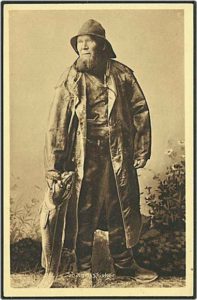 THOMAS GARDNER
THOMAS GARDNER
Thomas was born March 4 1592 to Sir Thomas Gardiner and Elizabeth White in Weymouth, Dorcet, England
Thomas, our 9th great grandfather, was placed in charge of the plantation and John Tilly of the fishing. The selection of the site for a plantation turned out to be unfortunate. The ground was rocky and the soil infertile and made farming impossible. There disappointment and struggle was great.
The fishing also proved a failure and many of the fisherman turned to agriculture for relief. The leader of the company in England, heard that Roger Conant was at Nantucket and thought perhaps he might be more successful so invited him to go to Cape Anne and take control. He went there in 1625 and soon realized that the lack of success had been because of the poor soil and that a settlement in this place could not be made profitable.
Conant searched the coast for a better plantation site and finally decided on the mouth of Naumkeag River which is now Salem. In 1626 The Dorchester Company gave him permission to move the little colony to the new location, though some of the first adventurers went to Virginia or returned to England. A few strong hearts stayed and became the founders of Salem.
 Conant said that they stayed “to the hazard of their lives”, and it is a shame that many historical writers of old Massachusetts fail to give the due credit for the laying of the foundation of this grand old Commonwealth. They proved that a settlement was possible, and sent one of their spokesman back to England to convince the Reverend John White and his associates that this was a possibility and asked for help and supplies. This resulted in the formation of the London Company and the sending of John Endicott in the ship “Abigail” in 1628.
Conant said that they stayed “to the hazard of their lives”, and it is a shame that many historical writers of old Massachusetts fail to give the due credit for the laying of the foundation of this grand old Commonwealth. They proved that a settlement was possible, and sent one of their spokesman back to England to convince the Reverend John White and his associates that this was a possibility and asked for help and supplies. This resulted in the formation of the London Company and the sending of John Endicott in the ship “Abigail” in 1628.
Thomas Gardner is thought to be the first man in authority on the land of what became the Massachusetts Bay Colony.
A meeting of the London company held July 28, 1629, it was mentioned “one Mr. Gardner, an able and expert man in divers faculties” by Mr. Webb, and he along with others were recommended for employment in the colony.
In 1635 we find that Thomas Gardner also signed his name to the grant of a three hundred a to Thomas Scruggs, and the next month to a grant of the same, to John Blackleech. His signature was of the town’s representative is appended to the records in the 11th mo, 1636.
In 1637 he was appointed to “survey all the fences between the meeting house westward of the Town, and in 1636 he was made a member of the First Church. 
Massachusetts Bay Colony admitted him as a freeman, in 1637, and he was appointed deputy to the General Court that same year. In 1637 he was among the 12 men appointed of the town. He served as juror during 1637 and 1638.
The town voted that every working man should devote the seventh day of the first month in 1638 to labor in repairing the highways, and Thomas Gardner was appointed as one of the three overseers to make sure the work was done and done properly.
He was called “Constable” in the town records in 1639, and various sums were recorded as being paid by him for court expenses. He also served the town as surveyor for the mending and keeper of the roads and was one of the record keepers of such.
Throughout his life Thomas Gardener’s name is found among the records in the the history of the town and he is renowned for his service to the colony. “Ole Mr. Gardener” he became known by amongst the residents of Old Salem.
Thomas first married Margaret Fryer/ Friar and they had nine children:
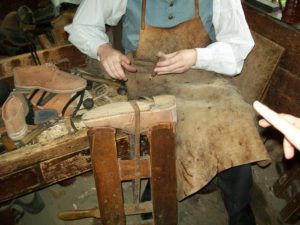 1. Lieut Thomas Gardner born in England and died in 1693. He first married Hannah and they had Mary, Thomas Eliza, Abigaile, Bethiah, Hannah, and Jonathan. He then married Elizabeth Horne, daughter of 2. Deacon John Horn, and they had David, Susannah, and Dorcas.
1. Lieut Thomas Gardner born in England and died in 1693. He first married Hannah and they had Mary, Thomas Eliza, Abigaile, Bethiah, Hannah, and Jonathan. He then married Elizabeth Horne, daughter of 2. Deacon John Horn, and they had David, Susannah, and Dorcas.
He was a cordwainer by trade. A cordwainer (/ˈkɔːrdˌweɪnər/) is a shoemaker who makes new shoes from new leather. The cordwainer’s trade can be contrasted with the cobbler’s trade, according to a tradition in Britain that restricted cobblers to repairing shoes. He also kept a general merchandise store and owned a ketch, the “John Booneyventure,” which was used in the cod fishing industry. He was prominent in town affairs and served from time to time on the jury. He lived in a house which stood on a lane running along the eastern boundary of the meeting house lot. His second wife, Elizabeth, died in 1695
2. George born in England and was married three times.
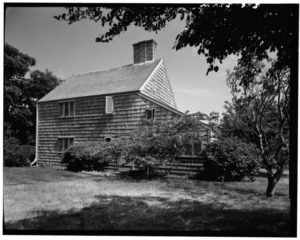
3. RICHARD (8th great grandfather) born 1621 Matock, Somerset, England. He married Sarah Shattuck, Quakeress, (daughter of Samuel and Damaris Shattuck, she being the second wife of Richard’s father Thomas.) Richards first grant of land was in 1642, a ten acre lot near Mackrell Cove, and he had later grants in Salem and at Jeffrey’s Creek. His house was on the eastern side of what is not Central Street, on the site of the present Salem Fraternity building. He had a shop on the same lot. He became a devout Quaker and with others was convicted of “absenting themselves from the public ordinances. ” He moved to Nantucket not long afterward and purchased land there at Wesko, Feb 15 1667. Richard became one of the leading men of the Nantucket Island and the ancestor of many, now distributed all over the country. He served as Chief Magistrate and represented the town at New York. He died March 23, 1688. His widow died in 1724, at the age of 93. She was an energetic and leading Quaker throughout her life. Their children were Joseph, Richard, Sarah, Deborah (7th great grandmother) who married John Macy, Damarice, James. Mariam, Nathaniel, Hope, and Love.
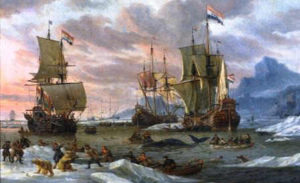 4. Captain John born 1624 married Priscilla Grafton daughter of Joseph. He was called Captain and was a master mariner and surveyor. He was given permission to build a mill over the South River in 1663. In 1669 he was paid for services as surveyor in the town. He lived in a house which stood near the corner of the present Herbert and Derby Streets in Salem. He was granted 11 acres and meadow land in Nantucket upon agreement: ” unto Mr. John Gardner of Salem marrener, a seamans accommodation, with all appurtinances belonging unto it as fully as the other seamen and tradesmen have in their former grants, upon condition that come to inhabit and set up the Trade fishing with a sufficient vessel fit for the taking of Codfish. Captain became very prominent, serving as Chief Magistrate, represetative to the General Court, “Captain and Chief Military Officer of the Foot Company,” and town moderator.
4. Captain John born 1624 married Priscilla Grafton daughter of Joseph. He was called Captain and was a master mariner and surveyor. He was given permission to build a mill over the South River in 1663. In 1669 he was paid for services as surveyor in the town. He lived in a house which stood near the corner of the present Herbert and Derby Streets in Salem. He was granted 11 acres and meadow land in Nantucket upon agreement: ” unto Mr. John Gardner of Salem marrener, a seamans accommodation, with all appurtinances belonging unto it as fully as the other seamen and tradesmen have in their former grants, upon condition that come to inhabit and set up the Trade fishing with a sufficient vessel fit for the taking of Codfish. Captain became very prominent, serving as Chief Magistrate, represetative to the General Court, “Captain and Chief Military Officer of the Foot Company,” and town moderator.
He died in May 1706, at the age of 82, and his gravestone is still preserved in the old Coffin house (horseshoe house), and a new one replacing it in the graveyard. His wife is said to have died in 1717. Their children were, John, Joseph, Priscilla, Benjamin, Rachel, George, Benjamin, Ann, Nathaniel, Mary, Mehitable (?), and Ruth.
5. SAMUEL born 1627 married first Mary White, and then Elizabeth Paine. His name appears in the Town Records in 1649 when he was ordered along with his brothers George, Thomas, and Joseph, to survey and measure from the meeting house to the parcel of meadow upon the great river Westerly from Salem” . He was often hired to survey around the town and colony. He served as appraiser and overseer of estates and had many terms of service on the grand jury and jury of trials. He was coroner, constable, selectman and deputy to the General courts, and was a leader in the affairs of the the First Church. His children were: Mary, Elizabeth, Margaret, Samuel, George, Jonathan, Hannah and Abel. He has numerous descendants who were prominent citizens of Salem, where many of them were merchants and ship owners during the time of the town’s great maritime prosperity. Many of them had notable records in the wars of the Colony, Province, and commonwealth. Samuel died Oct 1639.
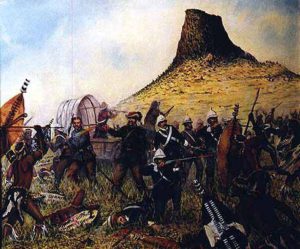 6. CAPTAIN JOSEPH born about 1628 and died 19 Dec 1675. Joseph married Ann Downing, daughter of Emanuel Downing, “gent” a prominent lawyer in London. He with his brothers John and Samuel was a surveyor and was frequently employed in that capacity. He kept a tavern and was called a vintner in some documents. He became a freeman in 1673 and served several times on the jury. In 1672 he was appointed with Henry Bartholomew, by the General Court on a committee for Essex and Norfolk, with others from Suffolk to settle accounts with Major Pynchon for pork received for the relief of his Majesty’s fleet in the Caribby Islands. In August of 1656 Lucy Downing, with the consent of her husband, Emanuel Downing, granted to him the plot of ground upon which the State Armory was built. As his dowry and marriage portion with Ann. The lot measured “fower acres of ground Intire”.
6. CAPTAIN JOSEPH born about 1628 and died 19 Dec 1675. Joseph married Ann Downing, daughter of Emanuel Downing, “gent” a prominent lawyer in London. He with his brothers John and Samuel was a surveyor and was frequently employed in that capacity. He kept a tavern and was called a vintner in some documents. He became a freeman in 1673 and served several times on the jury. In 1672 he was appointed with Henry Bartholomew, by the General Court on a committee for Essex and Norfolk, with others from Suffolk to settle accounts with Major Pynchon for pork received for the relief of his Majesty’s fleet in the Caribby Islands. In August of 1656 Lucy Downing, with the consent of her husband, Emanuel Downing, granted to him the plot of ground upon which the State Armory was built. As his dowry and marriage portion with Ann. The lot measured “fower acres of ground Intire”.
In the Massachusetts Bay Records May 15, 1672 it was recorded: “it is ordered that Joseph Gardiner be lieutenant to the foote company under the command of Walter Price, captain at Salem”. They marched with troops from Boston on the 8th. The 15th two of the men were killed and another wounded by Indians. Capt. Joseph Gardner, and others of the town went out immediately and killed an Indian who had slain one of the Salem troops and was wearing his cap.
The forces of Plymouth, Connecticut and Massachusetts attacked the Narragansetts in a swamp. After a three hour battle, the English took the enemy’s place and fired at their wigwams. One thousand of the Indians were killed. Eighty five of the English soldiers were killed or died of their wounds, and one hundred and forty five were wounded. Among those killed were Captain Gardner and six of his company, and eleven more of them were wounded.
“Major Church spying Capt. Gardner amidst the wigwams in the east end of the Fort made towards him; but suddenly, while looking at each other, Capt. Gardner settled down. The Major stepped up to him and seeing the blood run down his cheek, lifted his cap and called him by name. He looked up but spoke not a word, being mortally wounded, shot through the head, and observing the wound the Major ordered care to be taken of him.”
 His widow, Ann, married, in 1676, Governor Simon Bradstreet. She died April 19, 1713, at the age of 79 years. Captain Joseph Gardner had no children.
His widow, Ann, married, in 1676, Governor Simon Bradstreet. She died April 19, 1713, at the age of 79 years. Captain Joseph Gardner had no children.
7. SARAH born about 1630 and died Apr 5, 1686; married around 1650 to Benjamin Balch, the “Planter,” born in 1629 and lived in his father’s homestead. In 1930 the house was still standing on the corner of Cabot and Balch Streets in Beverly. He married two more times after her death.
They had seven sons and four daughters.
8. MIRIAM born about 1632 and died before Aug 1664 married John Hill who was born in Bristol, England around 1635. He was a wheelwright by trade ( a person who makes or repairs wooden wheels.) John and Miriam had two daughters, Miriam and Susanna.
9. SEETH was baptized October 25, 1636 and died the 17th of April, 1707. There has been some suggestion that her name could be a surname pasted down. She first married Joshua Conant, the son of Roger Conant, the “Planter”. He was a sea captain and lived in Marblehead. They had one child Joshua. Joshua (1) died in England in 1658 and Seeth married John Gratfton son of Joshua and Mary Grafton. After the death of Seeth, Mr. Grafton marriedd Judith Clark in Boston. He was a mariner and they had six children.
By now if you have been reading the history of our founding father’s you are starting to see the mention of several surnames that seem to intertwine. We are cousins of cousins for sure, but what an interesting story we have to tell.
I hope you have enjoyed this issue. If so please leave me a comment in the section below and let me know. If you have something to add I’d love to hear it also!
Happy Hunting!
THE PIERCE FAMILY HISTORIAN


Love your segments, and look forward to the next.
Hello Susan Pierce Holmes,
Fascinating reading your recent article on the Thomas Gardner (the Planter) Family. It seems my family lineage intersects early in American History at about the time of Richard Gardner and his wife Sarah Shattuck. I am currently having research done to confirm my family line from here, where I live in the state of Oregon, all the way back to Sherborne, Dorset England where Thomas was said to have begun the journey.
You certainly have an impressive photos and documentation. I commend your work. I, on the other hand am basically at the tip of the iceberg in my search. Which leads me to ask the question with regard to the Nantucket Gardners, would you be able to reference a good source? So far, one of my biggest sources has been Quaker Library at Earlham College Richmond Indiana. Thank your and grateful for your histories about my family. Steven Gardner
Steven so nice to meet you , so to speak. I love sharing info. I believe my best information on the Gardeners came from the North American Family Histories. I printed it out and it made quite a book. Title a biographical and genealogical record of the descendants of Thomas Gardner, Planter: cape Ann 1624 . I know you will enjoy it.
Hi Susan,
I recently found out via my niece who does ancestry, that Captain Thomas Gardiner ll is my 11th great grandfather. Thank you for this information it is very interesting!
So nice to meet you!